3. Error Sources and Behavior
a. Instrumental
Instrumental errors affecting total station distance and vertical angle measurements also affect trigonometric leveling results. These are described in the Total Station Instruments topic.
This section describes instrumental errors centering on the reflector rod.
(1) Reflector height (HR)
(a) Principle and behavior
If the reflector pole is set to 5.70 ft, is it really 5.70 ft from the bottom of the pole to the center of the reflector, Figure F-6?
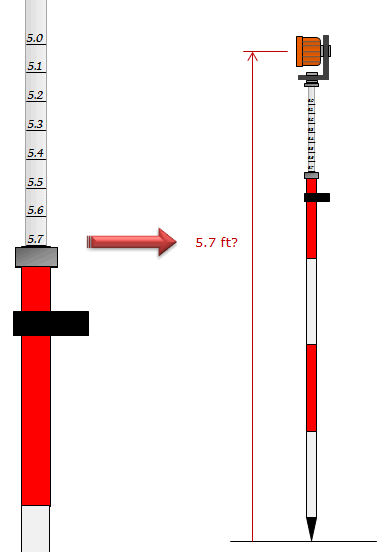 |
| Figure F-6 Prism Pole Uncertainty |
There are a few reasons the reflector pole reading may be incorrect:
How the reflector is mountedMost screw onto the top of the pole and are held in place using a lock nut. Depending on how far down the reflector is screwed will affect its height above the ground, Figure F-7. This is a systematic error.
|
 |
|
| Figure F-7 Reflector Mounting Height Difference |
||
Type of reflector usedDifferent reflector designs, single versus multiple reflectors, Figure F-8, have different center locations. This is also a systematic error.
|
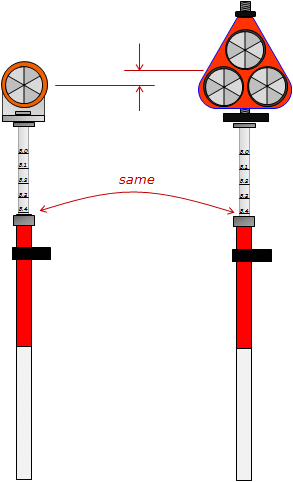 |
|
| Figure F-8 Reflector Type Height Difference |
||
Pole tipA regular pointed tip can sink in soft ground changing the reflector height. A topo shoe, having a blunt tip, is often used instead of the pointed tip. The blunt tip prevents the pole sinking in the ground maintaining a consistent HR regardless the terrain. But... The height of the topo shoe may be different than the pointed tip which could affect the pole height reading accuracy, Figure F-9. A pointed tip sinking is a random error; height difference between a pointed tip and topo shoe is a systematic error.
|
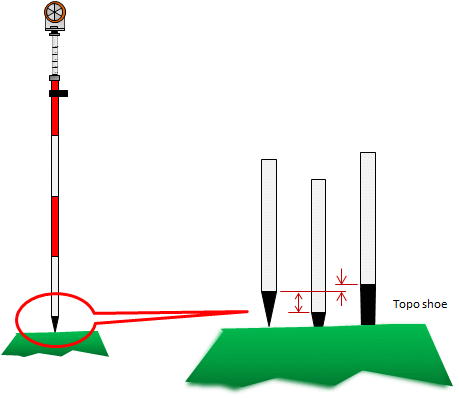 |
|
| Figure F-9 Pole Bottom Height Difference |
||
(b) Compensation
Use a topo shoe; unless surveying primarily on hard surface
(b) If a tape or pocket-rod is used to measure HI...
... it should also be used to set the HR.
For example, assume the HI measured with a tape is 5.35 ft, Figure F-10(a). With the reflector set to the same height using the tape, the pole reading is 5.52 ft, Figure F-10(b). Had the HR been set using a 5.35 ft pole reading, there would be almost 0.2 ft error in each measured elevation. The difference between the HI and the reading on the pole is a systematic error.
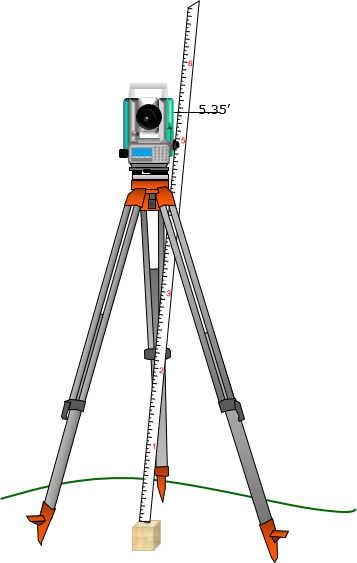 |
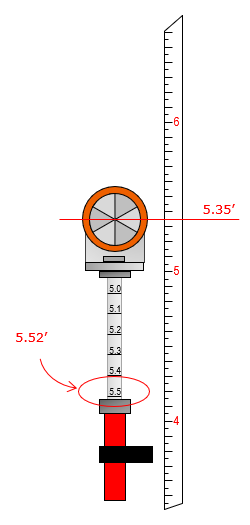 |
| (a) Taped Height | (b) Prism Height |
| Figure F-10 Prism Height Systematic Error |
|
(c) If the reflector pole is used to measure the HI...
... then as long as the same pole is used to measure points any height error is compensated. That's because the error is added in the HI and subtracted in the HR to determine point elevations.
However, an HI error can be introduced if the if the ground isn't flat, Figure F-11, making the pole bottom higher or lower than the point.
 |
| Figure F-11 Uneven Ground Slope |
In those situations a tape should be used to determine the HI and to set the reflector height.
If sighting a reference BM to establish the TSI elevation, Figure F-6, then pole reading error is automatically compensated as long as the same pole is used throughout. The pole height error is added to obtain the TSI elevation, then subtracted for point elevations. However, the TSI elevation will be incorrect by the pole reading error in the HRBM.
(2) Pole bubble
The reflector pole not being truly vertical has a greater effect on horizontal distance than vertical distance measurement. That's not to say a maladjusted bubble should be used for trigonometric leveling because that operation is generally combined with horizontal angles and distances to perform three dimensional surveys. The bubble on the reflector pole should be checked and adjusted as described in the XV. Equipment Checks and Adjustments B. The Grunt Stuff.
b. Natural
The same environmental conditions affecting distance measurement and angle measurement also affect trigonometric leveling.
c. Personal
Most personal errors are same as those in setting up a TSI and measuring angles with it:
- instrument setup (random)
- recording (mistake)
- computations (mistake)
- sighting (random)
along with HI and HR determination (both are mistakes).
How much HI error is introduced because the vertical distance from the ground to the TSI center can't be directly measured?
Example: For a typical set up, the taped distance is 5.25 ft from the ground to the TSI HA index mark. Using a 0.6 ft wide TSI, the true HI can be computed from simple trigonometry, Figure F-12:

 |
| Figure F-12 HI Measurement Error |
In this case, an error of only 0.02 ft is introduced in the TSI elevation. That's not much although it's not up to differential leveling standards. This is one reason we usually limit trigonometric leveling results to 0.1 feet.
Care and experience can eliminate mistakes and minimize random errors.